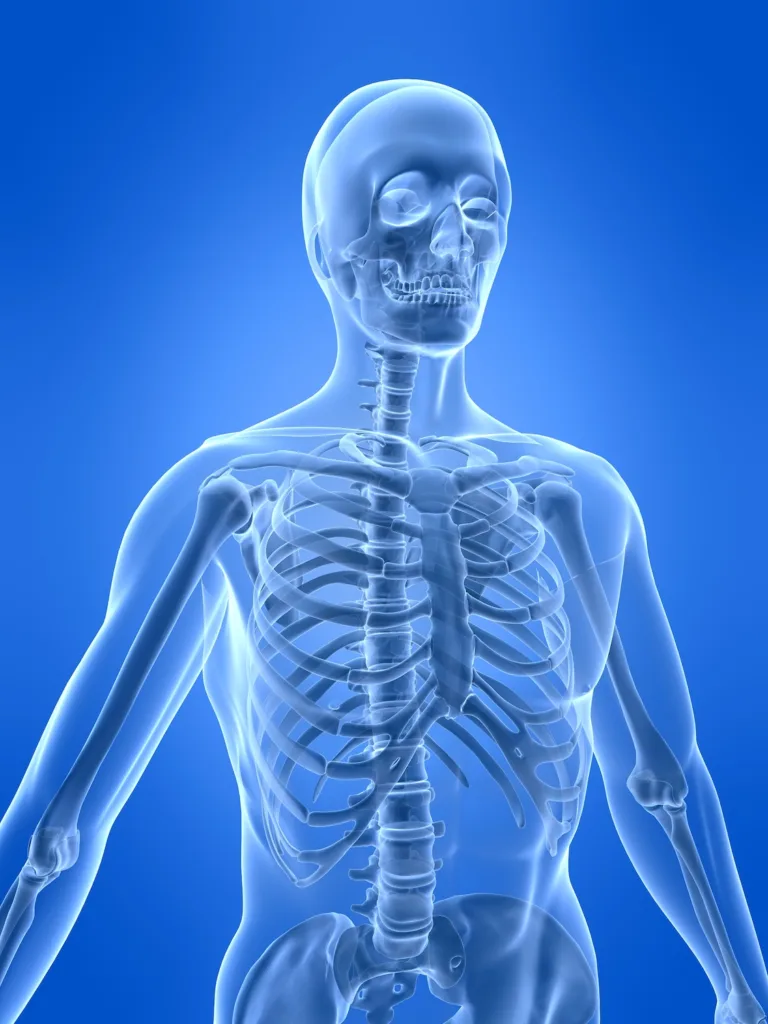The skeletal system is an essential part of the human body, comprising bones, cartilage, ligaments, and tendons. It provides a rigid framework that supports and protects the body’s internal organs and soft tissues. However, the skeletal system is not just an inert structure; it plays a critical role in maintaining homeostasis, the body’s internal balance, by regulating the levels of calcium and potassium in the blood, producing new blood cells, and storing energy.
One of the primary functions of the skeletal system is to store and release minerals such as calcium and potassium. Calcium is vital for bone growth and maintenance, muscle contraction, and nerve function. Potassium, on the other hand, is essential for maintaining the body’s fluid balance and regulating the heartbeat. The bones act as a reservoir for thse minerals, releasing them into the bloodstream as needed to maintain the body’s internal balance.
Another crucial role of the skeletal system is the production of blood cells. The bone marrow, located in the center of the bones, is responsible for producing red blood cells, white blood cells, and platelets. These cells are essential for carrying oxygen, fighting infections, and clotting blood when necessary. This process of blood cell production, known as hematopoiesis, is a vital component of the body’s homeostatic mechanisms.
In addition to storing minerals and producing blood cells, the skeletal system also plays a role in energy metabolism. The yellow marrow, found in the central cavities of long bones, stores triglycerides, a form of fat that can be used for energy when needed. This process helps maintain the body’s energy balance and provides a source of fuel during times of stress or fasting.
The skeletal system also provides structural support for the body, allowing for movement and protecting internal organs and tissues. The bones, along with ligaments and tendons, form a complex system of levers and joints that enable a wide range of movements, from walking and running to jumping and dancing. This ability to move and adapt to changing environments is essential for maintaining homeostasis and responding to internal and external stimuli.
The skeletal system is not just a static structure, but an active contributor to the body’s internal balance and homeostasis. By regulating the levels of minerals in the blood, producing new blood cells, storing energy, supporting movement, and protecting internal organs and tissues, the skeletal system plays a crucial role in maintaining the body’s health and well-being. Understanding the complex interactions between the skeletal system and other bodily systems is essential for maintaining optimal health and preventing disease.
Maintaining Homeostasis Through the Skeletal System
The skeletal system plays an important role in maintaining homeostasis in the human body. Here are two ways in which the skeletal system contributes to homeostasis:
1. Calcium and Potassium Storage and Release: The skeletal system stores large amounts of calcium and potassium, two essential minerals that play a vital role in various bodily functions such as muscle contraction, nerve function, and blood clotting. When the body requires tese minerals, the skeletal system releases them into the bloodstream, helping to maintain a stable concentration of these minerals in the body.
2. Blood Cell Formation: The bone marrow, located in the center of bones, is responsible for producing various blood cells, such as red blood cells, white blood cells, and platelets. These cells play an essential role in maintaining homeostasis by helping to transport oxygen and nutrients throughout the body, fighting off infections, and promoting blood clotting.
In addition to these two ways, the skeletal system also stores triglycerides, a type of fat, in the yellow marrow. This fat can be released into the bloodstream and used as an energy source when needed, helping to maintain energy homeostasis in the body.
The skeletal system plays a crucial role in maintaining homeostasis in the human body by contributing to various bodily functions, storing essential minerals, and producing blood cells.

Maintaining Homeostasis Through the Skeletal System
The skeletal system plays a crucial role in maintaining homeostasis in the body. One of its primary functions is to produce new red blood cells as the old ones die off. Red blood cells are responsible for carrying oxygen from the lungs to the different organs and tissues in the body. Hence, the production of new red blood cells is essential for maintaining the oxygen-carrying capacity of the blood.
In addition to this, the skeletal system also helps regulate the level of calcium in the bloodstream. Calcium is essential for varous bodily functions, including muscle contraction, nerve conduction, and blood clotting. If the calcium level in the blood is too high or too low, it can lead to various health problems.
The skeletal system maintains the calcium balance in the body by storing and releasing it as needed. When the body needs calcium, the bones release it into the bloodstream, and when there is an excess of calcium in the bloodstream, the bones absorb it to maintain the balance.
The skeletal system’s ability to produce new red blood cells and regulate calcium levels in the bloodstream is crucial for maintaining homeostasis in the body.
The Five Functions of the Skeletal System in Maintaining Homeostasis
The skeletal system is a vital component of the human body responsible for numerous functions that help maintain homeostasis. Homeostasis is the ability of the body to maintain a stable internal environment despite changes in external conditions. The skeletal system functions to support and protect soft tissues, facilitate movement, produce blood cells, and maintain mineral homeostasis.
1. Support and Protection of Soft Tissues:
The skeletal system provides structural support to the body, allowing us to maintain an upright posture and perform various movements. The bones of the skeleton also protect vital organs such as the brain, heart, and lungs. For example, the skull protects the brain from external injury, wile the rib cage protects the heart and lungs.
2. Facilitation of Movement:
The skeletal system works together with the muscular system to allow movement. Muscles attach to bones via tendons, and when the muscles contract, they pull on the bones, causing movement. The joints between bones allow for a wide range of movement.
3. Production of Blood Cells:
The skeletal system is responsible for producing blood cells, specifically red and white blood cells and platelets. Red blood cells transport oxygen to the body’s tissues, while white blood cells fight off infections. Platelets are responsible for blood clotting.
4. Mineral Homeostasis:
The skeletal system is also responsible for maintaining the body’s mineral homeostasis. Bones are a reservoir for minerals such as calcium, phosphorus, and magnesium. When the body needs these minerals, they are released from the bones into the bloodstream.
5. Endocrine Regulation:
The skeletal system also plays a role in endocrine regulation. Bones produce the hormone osteocalcin, which helps regulate blood sugar levels and improves insulin sensitivity.
The skeletal system is a complex and vital component of the human body responsible for numerous functions that help maintain homeostasis. From providing support and protection to facilitating movement and blood cell production, the skeletal system plays a crucial role in our overall health and well-being.
Regulation of Homeostasis by the Skeletal System
The skeletal system plays a crucial role in maintaining homeostasis in the human body. Homeostasis refers to the balance and stability of various physiological functions and processes, and the skeletal system contributes to this in several ways. Here are three forms of homeostasis that the skeletal system regulates:
1. Mineral homeostasis: The skeletal system is the primary storage site for minerals, such as calcium and phosphate, which are essential for various bodily functions. The bones continuously release and absorb minerals to maintain the balance of these minerals in the bloodstream. When the levels of these minerals in the blood becoe too low, the body releases hormones that stimulate the bones to release more minerals. Conversely, when the levels of these minerals become too high, the hormones stimulate the bones to absorb more minerals.
2. Acid-base balance: The bones also play a role in regulating the pH balance of the blood. When the blood becomes too acidic, the bones release minerals, such as calcium carbonate, to neutralize the acid and restore the pH balance. This process is known as buffering. Similarly, when the blood becomes too alkaline, the bones absorb minerals to restore the pH balance.
3. Blood cell production: The bone marrow, which is the spongy tissue inside the bones, is responsible for producing various types of blood cells. These include red blood cells, which carry oxygen to the body’s tissues, white blood cells, which help fight infections, and platelets, which help with blood clotting. The bone marrow produces these cells continuously to maintain the proper balance of blood cells in the body.
The skeletal system contributes to maintaining homeostasis in the body through mineral homeostasis, acid-base balance regulation, and blood cell production.

Conclusion
The skeletal system is an essential component of the human body that performs various functions that contribute to maintaining homeostasis. Its primary functions include providing support and protection to soft tissues, aiding in movement, producing blood cells, and maintaining mineral homeostasis. Through the coupling of osteoclasts and cells of the osteoblast lineage, the skeletal system can control bone resorption and the production of new bone tissue. It is crucial to maintain the health of the skeletal system to avoid conditions such as osteoporosis, arthritis, and other bone-related diseases. Therefore, it is essential to maintain a healthy diet and engage in regular physical activity to promote the overall health of the skeletal system.
